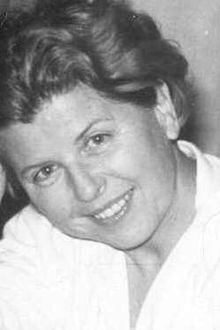- Maria Stader
-
 Maria Stader on Rigi-Kaltbad, New Year 1965
Maria Stader on Rigi-Kaltbad, New Year 1965
Maria Stader (November 5, 1911 – April 27, 1999) was a Hungarian born Swiss lyric soprano, known particularly for her Mozart interpretations.
Contents
Biography
Stader was born in Budapest, Hungary, on November 5, 1911, as Maria Molnár. During and after World War I, the price of food in Budapest was so high that it was difficult for her parents to support their five children. Maria and her younger sister, Elisabeth, were taken to Switzerland by The Salvation Army to recuperate for three months after being diagnosed with malnutrition. There, Maria's foster parents requested she stay for a full nine months. However, once in Budapest again, Maria fell seriously ill and it was also determined she would need her tonsils operated on. Her foster parents arranged for her to return to Switzerland. Because of difficulties with the aliens office police, Maria could not remain in the canton of Zürich, so her foster father found her a place with the Stader family in Romanshorn. They later adopted her.
In 1939, Stader married Hans Erismann, the music director of Weinfelden and later the choir director of the Zurich Opera House. Through the husband of her vocal teacher, Mathilde Bärlocher, she got acquainted with the Schulthess-Geyer couple. Stefi Geyer took special care of her after that. Her vocal teacher, Ilona Durigo, introduced her to Hermann and Lily Reiff (a student of Franz Liszt). The Reiffs' home was the frequent meeting place of Busch, Walter and Mann, the entire corona of the Opera House and Zürich Theater. Fritz Busch arranged for Maria Stader to go to the Schnabel School in Tremezzo a couple of years later. Maria Stader was a close friend of the Swiss politician, Walther Bringolf, as well as numerous musicians – especially pianist Clara Haskil and the Hungarian conductor Ferenc Fricsay (with whom she became acquainted through Rolf Liebermann). She was also a friend of the French film director, Emil-Edwin Reinert and she corresponded with Albert Schweitzer.
Education
Stader first received vocal instruction from Mathilde Bärlocher from St. Gallen, Switzerland, and as of 1930, from her father, Hans Keller, in Konstanz. As of 1935, Stader was educated by Ilona Durigo in Zürich and after that, she took lessons in Tremezzo from Therese Behr-Schnabel, the wife of Artur Schnabel. From 1938 on, Stader received training from Giannina Arangi-Lombardi in Milan.
Career
Stader first achieved fame for her interpretations of Mozart and her collaborations with conductor Ferenc Fricsay on pieces including Don Giovanni, Le nozze di Figaro, The Abduction from the Seraglio, and the Great Mass, as well as the Messa da Requiem. She won the Geneva International Competition in 1939, but although she "seemed poised for major stardom... her career was delayed by the outbreak of World War II," according to Opera News.[1] Later in her career Stader also acquired a reputation as an outstanding Bach interpreter, especially with Karl Richter and Ferenc Fricsay. She also recorded the Requiem by Antonín Dvořák with Karel Ančerl, and Fidelio (as Marzelline) with Hans Knappertsbusch.
Stader was highly praised for her fine, if not very powerful, voice. She nearly always performed operatic roles in the recording studio and seldom, if ever, on stage because of her small stature – she was about 1.44 metres (4 ft 9 in) tall. She also preferred the concert repertory that she loved. "Even in concert, she frequently had to stand on a platform or box in order to be seen properly by the audience," according to Opera News.[1]
This also enabled Stader to avoid the strain experienced by many operatic singers, and preserve her fresh and delicate-sounding voice until well into the 1960s. She stood on the concert podium for the last time in Philharmonic Hall in New York in the Mozart Requiem on December 7, 1969, "still in solid vocal condition."[1] Her concert tours had taken her around the world. Besides Europe and America, she also sang in Japan, South Africa and South America. Maria Stader sang in various festivals, including the Salzburg Festival, the Lucerne Festival, at the Prades Festival and at the Aspen Music Festival. She sang under the leadership of many well-known conductors including Eugen Jochum, Josef Krips, Eugene Ormandy, George Szell, Carl Schuricht, Rafael Kubelík, Bruno Walter, Hermann Scherchen, Otto Klemperer, Ernest Ansermet and Dean Dixon. Maria Stader taught at the Zurich Conservatory.
She died in Zürich on April 27, 1999.
Awards
- 1939 – First place, Geneva International Music Competition
- 1950 – Lilli Lehmann Medal, International Mozarteum Foundation
- 1956 – Silver Mozart Medal of the International Mozarteum Foundation
- 1964 – Hans Georg Nägeli Medal by the Zurich City Council[2]
Articles by Maria Stader
- Ferenc Fricsay, in: Diener der Musik. Unvergessene Solisten und Dirigenten unserer Zeit im Spiegel der Freunde. Publ. by Martin Müller and Wolfgang Mertz. Tübingen, Rainer Wunderlich, 1965.
- Zusammenarbeit mit Fricsay, in: Friedrich Herzfeld (Publ.): Ferenc Fricsay. Ein Gedenkbuch. Berlin, Rembrand, 1964.
- Über Wilhelm Furtwängler, in: Furtwängler Recalled. Zurich, Atlantis, 1965.
References
- ^ a b c "Maria Stader" in Opera News, July 1999.
- ^ "Preisträgerinnen und Preisträger 1932 bis 1998: Hans-Georg Nägeli-Medaille für Verdienste um das musikalische Schaffen", Zurich City Council (accessed 3 July 2010)
- Maria Stader, Nehmt meinen Dank. Erinnerungen. Accept My Thanks in English. Retold by Robert D. Abraham, Munich, 1979. (with repertoire, index of recordings and register of names)
- This article incorporates information from this version of the equivalent article on the German Wikipedia.
External links
- Biography with photographs
- Maria Stader in the German National Library catalogue (German)
- Entry for Maria Stader in the catalogue of the German National Library
Categories:- 1911 births
- 1999 deaths
- Operatic sopranos
- Swiss female singers
- Swiss opera singers
Wikimedia Foundation. 2010.

